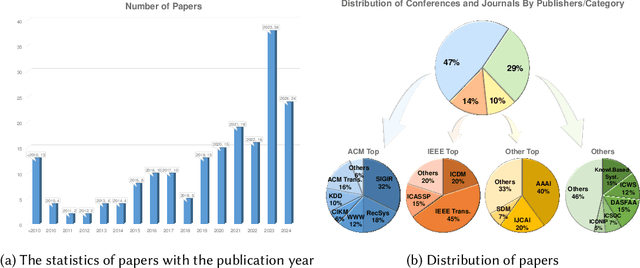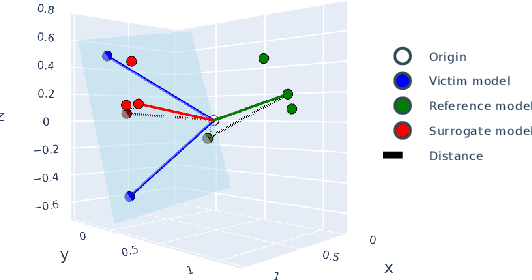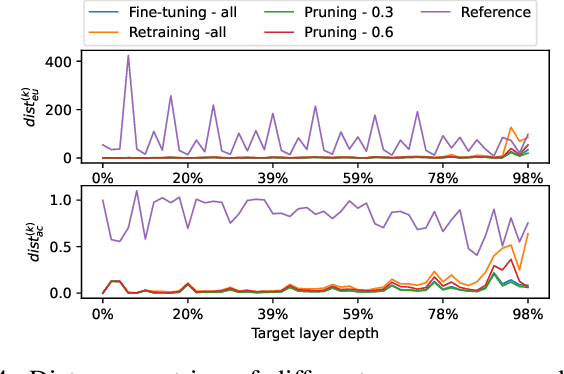Meng Sun
Calibrated Adversarial Sampling: Multi-Armed Bandit-Guided Generalization Against Unforeseen Attacks
Nov 15, 2025Abstract:Deep Neural Networks (DNNs) are known to be vulnerable to various adversarial perturbations. To address the safety concerns arising from these vulnerabilities, adversarial training (AT) has emerged as one of the most effective paradigms for enhancing the robustness of DNNs. However, existing AT frameworks primarily focus on a single or a limited set of attack types, leaving DNNs still exposed to attack types that may be encountered in practice but not addressed during training. In this paper, we propose an efficient fine-tuning method called Calibrated Adversarial Sampling (CAS) to address these issues. From the optimization perspective within the multi-armed bandit framework, it dynamically designs rewards and balances exploration and exploitation by considering the dynamic and interdependent characteristics of multiple robustness dimensions. Experiments on benchmark datasets show that CAS achieves superior overall robustness while maintaining high clean accuracy, providing a new paradigm for robust generalization of DNNs.
Automata-Based Steering of Large Language Models for Diverse Structured Generation
Nov 14, 2025Abstract:Large language models (LLMs) are increasingly tasked with generating structured outputs. While structured generation methods ensure validity, they often lack output diversity, a critical limitation that we confirm in our preliminary study. We propose a novel method to enhance diversity in automaton-based structured generation. Our approach utilizes automata traversal history to steer LLMs towards novel structural patterns. Evaluations show our method significantly improves structural and content diversity while maintaining comparable generation efficiency. Furthermore, we conduct a case study showcasing the effectiveness of our method in generating diverse test cases for testing open-source libraries.
When Thinking LLMs Lie: Unveiling the Strategic Deception in Representations of Reasoning Models
Jun 05, 2025Abstract:The honesty of large language models (LLMs) is a critical alignment challenge, especially as advanced systems with chain-of-thought (CoT) reasoning may strategically deceive humans. Unlike traditional honesty issues on LLMs, which could be possibly explained as some kind of hallucination, those models' explicit thought paths enable us to study strategic deception--goal-driven, intentional misinformation where reasoning contradicts outputs. Using representation engineering, we systematically induce, detect, and control such deception in CoT-enabled LLMs, extracting "deception vectors" via Linear Artificial Tomography (LAT) for 89% detection accuracy. Through activation steering, we achieve a 40% success rate in eliciting context-appropriate deception without explicit prompts, unveiling the specific honesty-related issue of reasoning models and providing tools for trustworthy AI alignment.
Mitigating Fine-tuning Risks in LLMs via Safety-Aware Probing Optimization
May 22, 2025Abstract:The significant progress of large language models (LLMs) has led to remarkable achievements across numerous applications. However, their ability to generate harmful content has sparked substantial safety concerns. Despite the implementation of safety alignment techniques during the pre-training phase, recent research indicates that fine-tuning LLMs on adversarial or even benign data can inadvertently compromise their safety. In this paper, we re-examine the fundamental issue of why fine-tuning on non-harmful data still results in safety degradation. We introduce a safety-aware probing (SAP) optimization framework designed to mitigate the safety risks of fine-tuning LLMs. Specifically, SAP incorporates a safety-aware probe into the gradient propagation process, mitigating the model's risk of safety degradation by identifying potential pitfalls in gradient directions, thereby enhancing task-specific performance while successfully preserving model safety. Our extensive experimental results demonstrate that SAP effectively reduces harmfulness below the original fine-tuned model and achieves comparable test loss to standard fine-tuning methods. Our code is available at https://github.com/ChengcanWu/SAP.
The Fusion of Large Language Models and Formal Methods for Trustworthy AI Agents: A Roadmap
Dec 09, 2024


Abstract:Large Language Models (LLMs) have emerged as a transformative AI paradigm, profoundly influencing daily life through their exceptional language understanding and contextual generation capabilities. Despite their remarkable performance, LLMs face a critical challenge: the propensity to produce unreliable outputs due to the inherent limitations of their learning-based nature. Formal methods (FMs), on the other hand, are a well-established computation paradigm that provides mathematically rigorous techniques for modeling, specifying, and verifying the correctness of systems. FMs have been extensively applied in mission-critical software engineering, embedded systems, and cybersecurity. However, the primary challenge impeding the deployment of FMs in real-world settings lies in their steep learning curves, the absence of user-friendly interfaces, and issues with efficiency and adaptability. This position paper outlines a roadmap for advancing the next generation of trustworthy AI systems by leveraging the mutual enhancement of LLMs and FMs. First, we illustrate how FMs, including reasoning and certification techniques, can help LLMs generate more reliable and formally certified outputs. Subsequently, we highlight how the advanced learning capabilities and adaptability of LLMs can significantly enhance the usability, efficiency, and scalability of existing FM tools. Finally, we show that unifying these two computation paradigms -- integrating the flexibility and intelligence of LLMs with the rigorous reasoning abilities of FMs -- has transformative potential for the development of trustworthy AI software systems. We acknowledge that this integration has the potential to enhance both the trustworthiness and efficiency of software engineering practices while fostering the development of intelligent FM tools capable of addressing complex yet real-world challenges.
A Survey on Bundle Recommendation: Methods, Applications, and Challenges
Nov 01, 2024



Abstract:In recent years, bundle recommendation systems have gained significant attention in both academia and industry due to their ability to enhance user experience and increase sales by recommending a set of items as a bundle rather than individual items. This survey provides a comprehensive review on bundle recommendation, beginning by a taxonomy for exploring product bundling. We classify it into two categories based on bundling strategy from various application domains, i.e., discriminative and generative bundle recommendation. Then we formulate the corresponding tasks of the two categories and systematically review their methods: 1) representation learning from bundle and item levels and interaction modeling for discriminative bundle recommendation; 2) representation learning from item level and bundle generation for generative bundle recommendation. Subsequently, we survey the resources of bundle recommendation including datasets and evaluation metrics, and conduct reproducibility experiments on mainstream models. Lastly, we discuss the main challenges and highlight the promising future directions in the field of bundle recommendation, aiming to serve as a useful resource for researchers and practitioners. Our code and datasets are publicly available at https://github.com/WUT-IDEA/bundle-recommendation-survey.
Emulators for stellar profiles in binary population modeling
Oct 14, 2024



Abstract:Knowledge about the internal physical structure of stars is crucial to understanding their evolution. The novel binary population synthesis code POSYDON includes a module for interpolating the stellar and binary properties of any system at the end of binary MESA evolution based on a pre-computed set of models. In this work, we present a new emulation method for predicting stellar profiles, i.e., the internal stellar structure along the radial axis, using machine learning techniques. We use principal component analysis for dimensionality reduction and fully-connected feed-forward neural networks for making predictions. We find accuracy to be comparable to that of nearest neighbor approximation, with a strong advantage in terms of memory and storage efficiency. By delivering more information about the evolution of stellar internal structure, these emulators will enable faster simulations of higher physical fidelity with large-scale simulations of binary star population synthesis possible with POSYDON and other population synthesis codes.
MILE: A Mutation Testing Framework of In-Context Learning Systems
Sep 07, 2024Abstract:In-context Learning (ICL) has achieved notable success in the applications of large language models (LLMs). By adding only a few input-output pairs that demonstrate a new task, the LLM can efficiently learn the task during inference without modifying the model parameters. Such mysterious ability of LLMs has attracted great research interests in understanding, formatting, and improving the in-context demonstrations, while still suffering from drawbacks like black-box mechanisms and sensitivity against the selection of examples. In this work, inspired by the foundations of adopting testing techniques in machine learning (ML) systems, we propose a mutation testing framework designed to characterize the quality and effectiveness of test data for ICL systems. First, we propose several mutation operators specialized for ICL demonstrations, as well as corresponding mutation scores for ICL test sets. With comprehensive experiments, we showcase the effectiveness of our framework in evaluating the reliability and quality of ICL test suites. Our code is available at https://github.com/weizeming/MILE.
Cross Fusion RGB-T Tracking with Bi-directional Adapter
Aug 30, 2024Abstract:Many state-of-the-art RGB-T trackers have achieved remarkable results through modality fusion. However, these trackers often either overlook temporal information or fail to fully utilize it, resulting in an ineffective balance between multi-modal and temporal information. To address this issue, we propose a novel Cross Fusion RGB-T Tracking architecture (CFBT) that ensures the full participation of multiple modalities in tracking while dynamically fusing temporal information. The effectiveness of CFBT relies on three newly designed cross spatio-temporal information fusion modules: Cross Spatio-Temporal Augmentation Fusion (CSTAF), Cross Spatio-Temporal Complementarity Fusion (CSTCF), and Dual-Stream Spatio-Temporal Adapter (DSTA). CSTAF employs a cross-attention mechanism to enhance the feature representation of the template comprehensively. CSTCF utilizes complementary information between different branches to enhance target features and suppress background features. DSTA adopts the adapter concept to adaptively fuse complementary information from multiple branches within the transformer layer, using the RGB modality as a medium. These ingenious fusions of multiple perspectives introduce only less than 0.3\% of the total modal parameters, but they indeed enable an efficient balance between multi-modal and temporal information. Extensive experiments on three popular RGB-T tracking benchmarks demonstrate that our method achieves new state-of-the-art performance.
Protecting Deep Learning Model Copyrights with Adversarial Example-Free Reuse Detection
Jul 04, 2024



Abstract:Model reuse techniques can reduce the resource requirements for training high-performance deep neural networks (DNNs) by leveraging existing models. However, unauthorized reuse and replication of DNNs can lead to copyright infringement and economic loss to the model owner. This underscores the need to analyze the reuse relation between DNNs and develop copyright protection techniques to safeguard intellectual property rights. Existing white-box testing-based approaches cannot address the common heterogeneous reuse case where the model architecture is changed, and DNN fingerprinting approaches heavily rely on generating adversarial examples with good transferability, which is known to be challenging in the black-box setting. To bridge the gap, we propose NFARD, a Neuron Functionality Analysis-based Reuse Detector, which only requires normal test samples to detect reuse relations by measuring the models' differences on a newly proposed model characterization, i.e., neuron functionality (NF). A set of NF-based distance metrics is designed to make NFARD applicable to both white-box and black-box settings. Moreover, we devise a linear transformation method to handle heterogeneous reuse cases by constructing the optimal projection matrix for dimension consistency, significantly extending the application scope of NFARD. To the best of our knowledge, this is the first adversarial example-free method that exploits neuron functionality for DNN copyright protection. As a side contribution, we constructed a reuse detection benchmark named Reuse Zoo that covers various practical reuse techniques and popular datasets. Extensive evaluations on this comprehensive benchmark show that NFARD achieves F1 scores of 0.984 and 1.0 for detecting reuse relationships in black-box and white-box settings, respectively, while generating test suites 2 ~ 99 times faster than previous methods.
 Add to Chrome
Add to Chrome Add to Firefox
Add to Firefox Add to Edge
Add to Edge